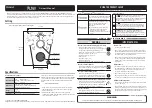
20
E N G L I S H
Safety instructions
When using power tools, always observe the safety
regulations applicable in your country to reduce the
risk of fi re, electric shock and personal injury.
Read all of this manual carefully before operating the
tool. Also refer to the manual of any power tool that
will be used with this tool.
Save this manual for future reference.
General
1
Keep work area clean
Cluttered areas and benches can cause accidents.
2
Consider work area environment
Do not expose power tools to humidity. Keep work
area well lit. Do not use power tools in the presence
of fl ammable liquids or gases.
3
Guard against electric shock
Prevent body contact with earthed surfaces (e.g.
pipes, radiators, cookers and refrigerators). For use
under extreme conditions (e.g. high humidity, when
metal swarf is being produced, etc.) electric safety
can be improved by inserting an isolating transformer
or a (FI) earth-leakage circuit-breaker.
4
Keep children away
Do not let children come into contact with the tool
or extension cord. Supervision is required for those
under 16 years of age.
5
Use appropriate tool
The intended use is described in this instruction
manual. Do not force small tools or attachments
to do the job of a heavy-duty tool. The tool will do
the job better and safer at the rate for which it was
intended.
Warning!
The use of any accessory or attachment
or performance of any operation with this tool, other
than those recommended in this instruction manual
may present a risk of personal injury.
6
Maintain tools with care
Keep the tools in good condition and clean for better
and safer performance. Follow the instructions for
maintenance and changing accessories. Inspect the
tool cords at regular intervals and, if damaged, have
them repaired by an authorized BTI repair agent.
Keep all controls dry, clean and free from oil and
grease.
7 Store
idle
tools
When not in use, power tools must be stored in a
dry place and locked up securely, out of reach of
children.
8
Check for damaged parts
Before using the tool, carefully check it for damage
to ensure that it will operate properly and perform
its intended function. Check for misalignment and
seizure of moving parts, breakage of parts and any
other conditions that may affect its operation. Have
damaged guards or other defective parts repaired
or replaced as instructed. Do not use the tool if the
switch is defective. Have the switch replaced by an
authorized BTI repair agent.
9 Remove
the
batteries
Remove the batteries when not in use, before
servicing and when changing accessories.
10 Have your tool repaired by an authorized BTI
repair agent
This power tool is in accordance with the relevant
safety regulations. To avoid danger, electric
appliances must only be repaired by qualified
technicians.
Additional safety instructions for batteries
•
Do not attempt to recharge batteries.
•
Do not open or mutilate batteries for any reason.
•
Do not expose batteries to water.
•
Do not expose batteries to fi re.
•
Do not attempt to recharge batteries.
•
Do not store batteries in locations where the
temperature may exceed 40 °C.
•
Use only the correct size of batteries. When replacing,
do not mix old batteries with new ones.
•
Under extreme conditions, battery leakage may
occur. When you notice liquid leaking out, proceed
as follows:
-
Carefully wipe the liquid off using a cloth. Avoid
skin or eye contact. Do not swallow.
-
In case of skin or eye contact, rinse the liquid off
with clean fl owing water for at least 10 minutes
and contact a doctor.
Fire hazard! Avoid short-circuiting the contacts
of a removed battery.
Additional safety instructions for lasers
•
This laser complies with class 2 according to
EN 60825-1:1994+A11. Do not replace a laser diode
with a different type. If damaged, have the laser
repaired by an authorised repair agent.
•
Do not use the laser for any purpose other than
projecting laser lines.
An exposure of the eye to the beam of a class 2 laser is
considered safe for a maximum of 0.25 seconds. Eyelid
refl exes will normally provide adequate protection. At
distances over 1 m, the laser complies with class 1 and
thus is considered completely safe.
•
Never look into the laser beam directly and
intentionally.
•
Do not use optical tools to view the laser beam.
•
Do not set up the tool at a position where the laser
beam can cross any person at head height.
Summary of Contents for Profiline BTI-KLL 20
Page 1: ......
Page 2: ...2 Copyright BTI Deutsch 10 English 16 Français 22 Polski 28 Русский язык 34 ...
Page 3: ...2 Copyright BTI Español 10 Português 16 Italiano 22 Nederlands 28 Eλληνικα 34 ...
Page 4: ...3 ...
Page 5: ...4 ...
Page 6: ...5 ...
Page 7: ...6 ...
Page 8: ...7 ...
Page 9: ...8 ...
Page 10: ...9 ...
















































